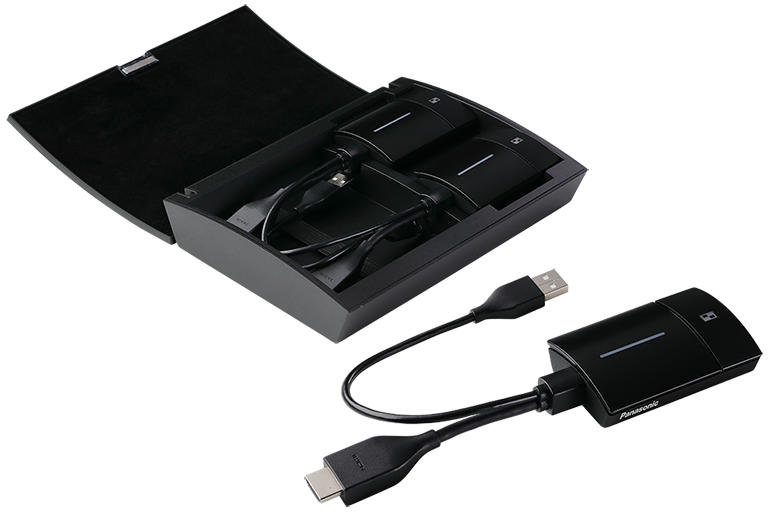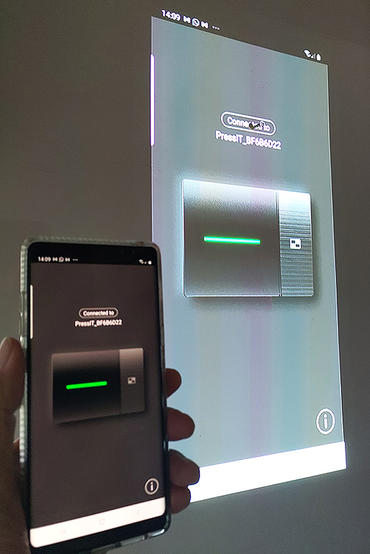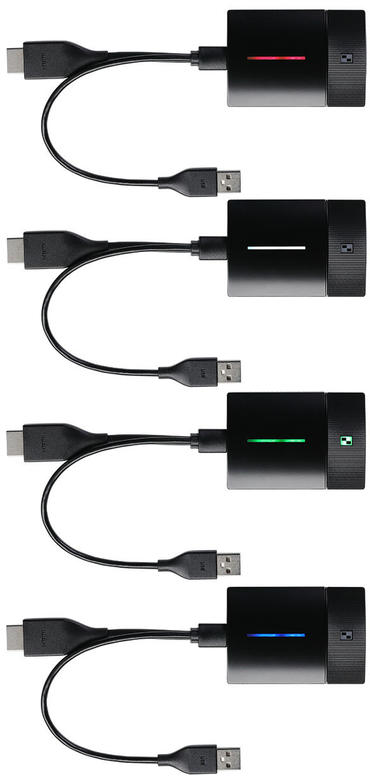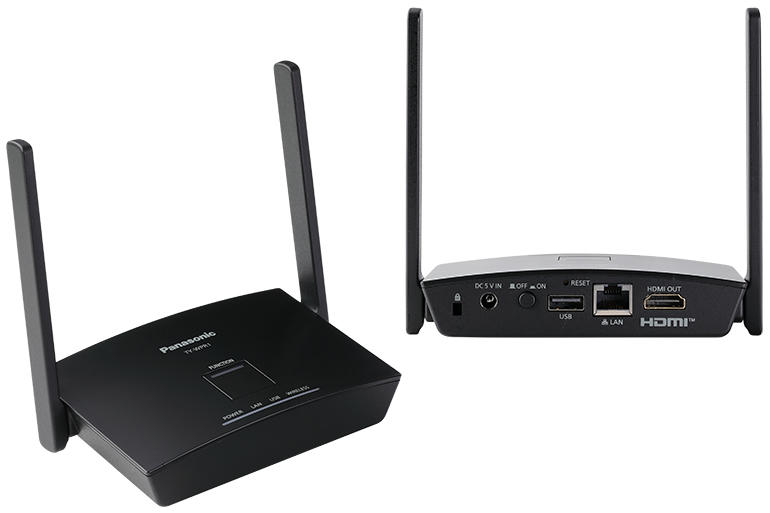Modern workforces increasingly require quick and flexible connections to displays such as large monitors and projectors in meeting rooms, huddle rooms and other collaborative workspaces. Quick, because you don’t want to hold up colleagues or clients before a presentation by wrestling with cables and settings; and flexible because content that might prove useful to display during a meeting can come from multiple sources, not just the presenter’s laptop or PC.
Panasonic’s solution to these workplace problems is the PressIT Wireless Presentation System (WPS), an HDMI cable-replacement system based around a receiver that attaches to the monitor or projector, and press-to-present transmitters on content-containing devices such as PCs, laptops, tablets and smartphones.
Design
The PressIT WPS components are not designed to be on show, and therefore have an inconspicuous, utilitarian look. The Basic Set sent to ZDNet for review, which costs €1,237 (~£1,101 ex. VAT or $1,492), comprises a receiver unit and two transmitters, a box for the transmitters and their cables, plus an AC adapter and cables for the receiver, along with various mounting brackets. The whole kit comes in a sturdy fabric-clad zip-up case.
The PressIT receiver, which plugs into your meeting room display, creates a 5GHz 802.11ac wi-fi network with a range of up to 30m. It’s also available in Intel SDM format.
Images: Panasonic
The receiver (TY-WPR1) is a small (120mm x 26mm x 81mm) router with a pair of antennas for its 5GHz 802.11ac connections. The top has a Function button that’s used to save pairing information over a USB connection. At the back there are HDMI, RJ-45 Ethernet and USB-A ports, along with power and reset buttons, a round-pin power input and a security slot. An alternative to the standalone receiver (not supplied for review) comes as an Intel SDM (Smart Display Module) unit that plugs into an SDM slot on the back of a compatible display. The SDM receiver board costs €520 (~£463 ex. VAT or $627).


The PressIT Basic Set comes with two USB-A/HDMI transmitters. A USB-C model is also on the way.
Images: Panasonic


You can mirror your Android device’s screen using the PressIT app. There’s no equivalent iOS app though.
Image: Charles McLellan / ZDNet
The transmitter supplied with the Basic Set (TY-WPB1) is a mouse-sized (51mm x 21mm x 73mm) unit with two fixed cables – USB-A for power and HDMI for video. There’s a USB-A port on the unit for transferring pairing information from the Receiver via a USB stick, and a mode switch (STD/EXT; the latter being engaged when a USB stick is inserted). The two Basic Set transmitters are paired out of the box — USB pairing is for additional units, which cost €353 (~£314 ex. VAT or $426) each. The transmitter, which has an antibacterial surface treatment, has two buttons on top: the main one, with a large status LED, switches image display on and off, while the secondary one, with a small status LED, controls multi-screen mode (up to four FHD screens can be displayed at once). The back of the transmitter is magnetic, so the unit can be placed somewhere convenient.
There’s a second transmitter (TY-WPBC1) with a single USB-C cable for power and video, which also costs €353 (~£314 ex. VAT or $426). This will be more convenient for mobile devices, although there is an app that will do the job for Android devices. You’ll need to use an adapter such as Apple’s USB-C Digital AV Multiport Adapter (£75) to connect an iPhone or iPad using the standard (USB/HDMI) transmitter or buy a USB-C unit, as there’s currently no iOS app available.
Features
Top ZDNET Reviews
The transmitters support wireless HDMI audio and video output at 1080p (FHD, 1920×1080/60fps) resolution, and the receiver can have up to 32 of them connected simultaneously within a 30m range, with up to four displayable on-screen at a time (3840×2160/30fps). The receiver supports HDMI-CEC (Consumer Electronics Control), which allows for communication with compliant display devices.
When multiple transmitters are connected, the main presenter may want to ensure that his or her screen isn’t accidentally bumped off the display by other PressIT-equipped attendees: this can be prevented using Fixed mode, which is engaged by holding down the main button for two or more seconds, whereupon the status LED changes from green to blue and other transmitters are locked out. Another long press on the presenter’s main button disengages Fixed mode.
Performance & user experience


PressIT transmitter LED colours: red (disconnected or connecting); white (pairing or paired); green (screen sharing); and blue (Fixed mode). The secondary green LED shows when multi-screen mode is engaged.
Images: Panasonic
The PressIT system is straightforward to set up and use: for this evaluation, I went from unboxing to displaying my PC’s screen wirelessly on a projector in about 30 minutes. With everything unpacked and installed in a meeting room, getting content up on a big screen during a meeting should be near-instantaneous. There will be significantly less wiring clutter, too.
There’s no software or drivers to install: to get started, you connect the Receiver to your monitor or projector via HDMI and supply power either via the 5V/1.5A AC adapter or over a USB connection, and then press the power button on the back. The display will now show a Panasonic splash Screen telling you what to do next: connect the transmitter(s) to HDMI and USB on your client devices and wait for the main LED to cycle through red blinking (connecting), white blinking (pairing in progress) and solid white (paired). Press the main button now and the screen will get the green light and be shared on the presentation display, while a long press will engage Fixed mode and turn the LED blue, as described above. To add your screen to the presentation display (so long as Fixed mode isn’t in operation), you press the secondary button on the transmitter, whose LED then glows green.
As far as video and audio are concerned, there’s little if any loss of quality over the wireless connection compared to a regular HDMI cable, and minimal latency. With only two transmitters in my review kit I couldn’t test the receiver’s full 4K capability (4x 1080p streams), but there’s no reason to suspect it will struggle with that.
Manageability and security are always key issues for businesses, so IT managers will be pleased that the settings screen offers plenty of adjustments, including: output resolution for the presentation display (up to 4096×2160/24fps); maximum number of connections (up to 32); screen mode (fit to screen or stretch to full screen); wireless channel; LAN IP settings; SSID (name change, hide, turn off); admin password; WPA/WPA2 Enterprise digital certificate upload; and firmware upgrade.
Conclusions
Panasonic’s PressIT Wireless Presentation System does its job – replacing HDMI cable connections to meeting room monitors or projectors with wireless links – with minimal fuss and good attention to detail, although it’s a shame there’s no iOS app available.
At €1,237 (~£1,101 ex. VAT or $1,492), PressIT WPS is a competitive alternative to Barco’s ClickShare CSE-200, which costs £1,490 (ex. VAT) but only supports 16 connections and 2 simultaneous displays, although it does have both Android and iOS apps. Benq’s InstaShow S WDC20 has a similar specification to PressIT — 32 connections, 4 displays — and supports Android and iOS, but is more expensive at £1,225-£2,054 (ex. VAT) online.
RECENT AND RELATED CONTENT
Logitech launches Rally Bar, Rally Bar Mini, RoomMate systems for conference rooms
Switching from WhatsApp to Signal (or something else)? Here’s what you need to know
The complete Zoom guide: From basic help to advanced tricks
CES 2021: Dell launches monitors, Latitude, OptiPlex, Precision devices aimed at work’s new normal
Back to the office in 2021? Here are ten things that will have changed
Read more reviews



